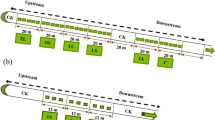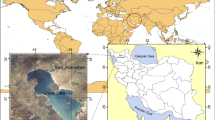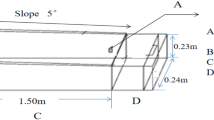Abstract
Agricultural non-point source (ANPS) pollution is an important contributor to elevated nitrogen (N) and phosphorus (P) in surface waters, which can cause serious environmental problems. Considerable effort has therefore gone into the development of methods that control the ANPS input of N and P to surface waters. Phytoremediation has been extensively used because it is cost-effective, environmentally friendly, and efficient. The N and P loads from agricultural drainage are a potential threat to the water quality of the Yellow River in Ningxia, China. Yet, phytoremediation has only rarely been applied within the Ningxia irrigation area. In an experimental set-up, five species (Ipomoea aquatica, IA; Lactuca sativa, LS; Oryza sativa, OS; Typha latifolia, TL; Zizania latifolia, ZL) were evaluated for their ability to reduce N and P loads over 62 days and five observation periods. Total N and P concentrations, plant biomass, and nutrient content were measured. The results showed that OS, LS, and IA performed better than ZL and TL in terms of nutrients removal, biomass accumulation, and nutrients storage. The highest overall removal rates of N and P (57.7 and 57.3%, respectively) were achieved by LS treatment. In addition, plant uptake contributed significantly to nutrient removal, causing a 25.9–72.0% reduction in N removal and a 54.3–86.5% reduction in P removal. Thus, this study suggests that OS, LS, and IA would be more suitable than ZL and TL for controlling nutrient loads in the Ningxia irrigation area using phytoremediation.




Similar content being viewed by others
References
Abe, K., Kato, K., & Ozaki, Y. (2010). Vegetation-based wastewater treatment technologies for rural areas in Japan. Japan Agricultural Research Quarterly, 44, 231–242.
Abe, K., Komada, M., & Ookuma, A. (2014). Purification performance of a shallow free-water-surface constructed wetland receiving secondary effluent for about 5 years. Ecological Engineering, 69, 126–133.
Alexander, R. B., Smith, R. A., Schwarz, G. E., Boyer, E. W., Nolan, J. V., & Brakebill, J. W. (2008). Differences in phosphorus and nitrogen delivery to the Gulf of Mexico from the Mississippi river basin. Environmental Science and Technology, 42, 822–830.
Asaeda, T., Nam, L. H., Peter, H., Norio, T., & Shiromi, K. (2002). Seasonal fluctuations in live and dead biomass of Phragmites australis as described by a growth and decomposition model: implications of duration of aerobic conditions for litter mineralization and sedimentation. Aquatic Botany, 73, 223–239.
Bachand, P. A. M., & Horne, A. J. (2000). Denitrification in constructed free-water surface wetlands: II. effects of vegetation and temperature. Ecological Engineering, 14, 17–32.
Barat, R., Montoya, T., Seco, A., & Ferrer, J. (2011). Modelling biological and chemically induced precipitation of calcium phosphate in enhanced biological phosphorus removal systems. Water Research, 45, 3744–3752.
Beutel, M. W., Newton, C. D., Brouillard, E. S., & Watts, R. J. (2009). Nitrate removal in surface-flow constructed wetlands treating dilute agricultural runoff in the lower Yakima Basin, Washington. Ecological Engineering, 35, 1538–1546.
Bowden, W. B. (1987). The biogeochemistry of nitrogen in freshwater wetlands. Biogeochemistry, 4, 313–348.
Brix, H. (1997). Do macrophytes play a role in constructed treatment wetlands? Water Science and Technology, 35, 11–17.
Bu, F. P., & Xu, X. Y. (2013). Planted floating bed performance in treatment of eutrophic river water. Environmental Monitoring and Assessment, 185, 9651–9662.
Chang, J. J., Wu, S. Q., Dai, Y. R., Liang, W., & Wu, Z. B. (2013). Nitrogen removal from nitrate-laden wastewater by integrated vertical-flow constructed wetland systems. Ecological Engineering, 58, 192–201.
China State Environment Protection Administration. (2002). Monitoring and analytical method of water and wastewater. Beijing: China Environmental Science Press (in Chinese).
Cui, L. H., Zhu, X. Z., Ouyang, Y., Chen, Y., & Yang, F. L. (2011). Total phosphorus removal from domestic wastewater with Cyperus alternifolius in vertical-flow constructed wetlands at the microcosm level. International Journal of Phytoremediation, 13, 692–701.
Duan, J. J., Feng, Y. F., & Yu, Y. L. (2016). Differences in the treatment efficiency of a cold-resistant floating bed plant receiving two types of low-pollution wastewater. Environmental Monitoring and Assessment, 188, 1–11.
Fang, Y. Y., Yang, X. E., Chang, H. Q., Pu, P. M., Ding, X. F., & Rengel, Z. (2007). Phytoremediation of nitrogen-polluted water using water hyacinth. Journal of Plant Nutrition, 30, 1753–1765.
Ge, Z. G., Feng, C. M., Wang, X. P., & Zhang, J. B. (2016). Seasonal applicability of three vegetation constructed floating treatment wetlands for nutrient removal and harvesting strategy in urban stormwater retention ponds. International Biodeterioration and Biodegradation, 112, 80–87.
Gersberg, R. M., Elkins, B. V., Lyon, S. R., & Goldman, C. R. (1986). Role of aquatic plants in wastewater treatment by artificial wetlands. Water Research, 20, 363–368.
Hoagland, D. R., & Arnon, D. I. (1938). The water culture method for growing plants without soil. California Agricultural Experiment Station, 347, 1–39.
Huang, W., Chen, Q. W., & Ren, K. X. (2015). Vertical distribution and retention mechanism of nitrogen and phosphorus in soils with different macrophytes of a natural river mouth wetland. Environmental Monitoring and Assessment, 187, 1–10.
Kröger, R., Moore, M. T., Locke, M. A., Cullum, R. F., Steinriede Jr, R. W., Testa, S., Bryant, C. T., & Cooper, C. M. (2009). Evaluating the influence of wetland vegetation on chemical residence time in Mississippi Delta drainage ditches. Agricultural Water Management, 96, 1175–1179.
Lena, B. V. (1994). Nutrient preserving in riverine transitional strip. Journal of Human Environment, 3, 342–347.
Li, C. J., Dong, Y., Lei, Y. H., Wu, D. Y., & Xu, P. (2015). Removal of low concentration nutrients in hydroponic wetland integrated with zeolite and calcium silicate hydrate functional substrates. Ecological Engineering, 82, 442–450.
Liu, G. Q., & Yang, S. Q. (2010). Analyzed on present situation of subsiding water form cropland in Ningxia irrigation area from the Huanghe River. Journal of Irrigation and Drainage, 29, 104–108 (in Chinese).
Lu, R. K. (2000). Soil agricultural chemical analysis method. Beijing: China Agricultural Science and Technology Press (in Chinese).
Lu, S. Y., Wu, F. C., Lu, Y. F., Xiang, C. S., Zhang, P. Y., & Jin, C. X. (2009). Phosphorus removal from agricultural runoff by constructed wetland. Ecological Engineering, 35, 402–409.
Lucas, W. C., & Greenway, M. (2008a). Nutrients retention in mature vegetated bioretention systems under elevated nutrients loads. Proceedings of the World Environment and Water Resources Congress, 1-10.
Lucas, W. C., & Greenway, M. (2008b). Nutrients retention in vegetated and nonvegetated bioretention mesocosms. Journal of Irrigation and Drainage Engineering, 134, 613–623.
Ma, K. X., Wu, H. Q., Zhu, D. H., & Mu, X. (2011). Purification of irrigation return flow by cultivating rice on water surface in Ningxia irrigation area. Journal of Irrigation and Drainage, 30, 103–106 (in Chinese).
Ma, L., He, F., Huang, T., Zhou, Q. H., Zhang, Y., & Wu, Z. B. (2016). Nitrogen and phosphorus transformations and balance in a pond-ditch circulation system for rural polluted water treatment. Ecological Engineering, 94, 117–126.
Moore, M. T., Kröger, R., Locke, M. A., Cullum, R. F., Steinriede Jr., R. W., Testa, S., Lizotte Jr., R. E., Bryant, C. T., & Cooper, C. M. (2010). Nutrient mitigation capacity in Mississippi Delta, USA drainage ditches. Environmental Pollution, 158, 175–184.
Ningxia Autonomous Region Environmental Protection Bureau. (2012-2015). Ningxia Autonomous Region Environmental Bulletin, http://www.nxep.gov.cn/hjjczxz/hjzl/hjzlxx/hjzkgb.htm. (in Chinese).
Ojoawo, S. O., Udayakumar, G., & Naik, P. (2015). Phytoremediation of phosphorus and nitrogen with Canna x generalis reeds in domestic wastewater through NMAMIT constructed wetland. Aquatic Procedia, 4, 349–356.
Ongley, E. D., Zhang, X. L., & Yu, T. (2010). Current status of agricultural and rural non-point source pollution assessment in China. Environmental Pollution, 158, 1159–1168.
Prochaska, C. A., & Zouboulis, A. I. (2006). Removal of phosphates by pilot vertical-flow constructed wetlands using a mixture of sand and dolomite as substrate. Ecological Engineering, 26, 293–303.
Qin, H. J., Zhang, Z. Y., & Liu, M. H. (2016). Site test of phytoremediation of an open pond contaminated with domestic sewage using water hyacinth and water lettuce. Ecological Engineering, 95, 753–762.
Roley, S. S., Tank, J. L., Tyndall, J. C., & Witter, J. D. (2016). How cost-effective are cover crops, wetlands, and two-stage ditches for nitrogen removal in the Mississippi River Basin? Water Resources and Economics, 15, 43–56.
Sirivedhin, T., & Gray, K. A. (2006). Factors affecting denitrification rates in experimental wetlands: field and laboratory studies. Ecological Engineering, 26, 167–181.
Tanner, C. C. (1996). Plants for constructed wetland treatment systems—a comparison of the growth and nutrient uptake of eight emergent species. Ecological Engineering, 7, 59–83.
Thongtha, S., Teamkao, P., Boonapatcharoen, N., Tripetchkul, S., Techkarnjararuk, S., & Thiravetyan, P. (2014). Phosphorus removal from domestic wastewater by Nelumbo nucifera Gaertn. and Cyperus alternifolius L. Journal of Environmental Management, 137, 54–60.
Torit, J., Siangdung, W., & Thiravetyan, P. (2012). Phosphorus removal from domestic wastewater by Echinodorus cordifolius L. J. Environ Journal of Environmental Science and Health, Part A, 47, 794–800.
Tyler, H. L., Moore, M. T., & Locke, M. A. (2012). Influence of three aquatic macrophytes on mitigation of nitrogen species from agricultural runoff. Water, Air, & Soil Pollution, 223, 3227–3236.
Wang, J. Z., Jiang, X., Zheng, B. H., Chen, C. X., Kang, X. M., Zhang, C. Y., Song, Z. Q., Wang, K., Wang, W. W., & Wang, S. H. (2016). Effect of algal bloom on phosphorus exchange at the sediment-water interface in Meiliang Bay of Taihu Lake, China. Environmental Earth Sciences, 75, 1–9.
Wang, Z., Zhang, Z. Y., Zhang, Y. Y., Zhang, J. Q., Yan, S. H., & Guo, J. Y. (2013). Nitrogen removal from Lake Caohai, a typical ultra-eutrophic lake in China with large scale confined growth of Eichhornia crassipes. Chemosphere, 92, 177–183.
Wen, L., & Recknagel, F. (2002). In situ removal of dissolved phosphorus in irrigation drainage water by planted floats: preliminary results from growth chamber experiment. Agriculture Ecosystems & Environment, 90, 9–15.
Wu, Q., Hu, Y., Li, S. Q., Peng, S., & Zhao, H. B. (2016). Microbial mechanisms of using enhanced ecological floating beds for eutrophic water improvement. Bioresource Technology, 211, 451–456.
Wu, X., Yang, X. E., & Zed, R. (2009). Phytoremediation facilitates removal of nitrogen and phosphorus from eutrophicated water and release from sediment. Environmental Monitoring and Assessment, 157, 277–285.
Xie, L. Q., Xie, P., & Tang, H. J. (2003). Enhancement of dissolved phosphorus release from sediment to lake water by Microcystis blooms—an enclosure experiment in a hyper-eutrophic, subtropical Chinese lake. Environmental Pollution, 122, 391–399.
Xue, L. H., Yu, Y. Q., & Yang, L. Z. (2011). Nitrogen balance and environmental impact of paddy field under different N management methods in Taihu Lake Region. Environmental Science, 32, 1133–1139 (in Chinese).
Yeh, N., Yeh, P., & Chang, Y. H. (2015). Artificial floating islands for environmental improvement. Renewable and Sustainable Energy Reviews, 47, 616–622.
Zhang, Y. Y., Zhang, Z. Y., Chen, Z. C., Liu, H. Q., Wen, X. Z., Qin, H. J., & Yan, S. H. (2016). Phosphorus removal pathways in water hyacinth (Eichhornia crassipes) ecological restoration systems and influence on phosphorus release in sediment by the macrophyte. Journal of Nanjing Agricultural University, 39, 106–113 (in Chinese).
Zhao, Y. G., Fang, Y., & Jin, Y. L. (2014). Potential of duckweed in the conversion of wastewater nutrients to valuable biomass: a pilot-scale comparison with water hyacinth. Bioresource Technology, 163, 82–91.
Zhu, L. D., Li, Z. H., & Ketola, T. (2011). Biomass accumulations and nutrient uptake of plants cultivated on artificial floating beds in China’s rural area. Ecological Engineering, 37, 1460–1466.
Acknowledgements
This work was financially supported by National Nature Science Foundation of China (31170416) and Innovation Project of Chinese Academy of Agricultural Sciences’ Clean Watershed Group.
Author information
Authors and Affiliations
Corresponding author
Rights and permissions
About this article
Cite this article
Chen, C., Zhao, T., Liu, R. et al. Performance of five plant species in removal of nitrogen and phosphorus from an experimental phytoremediation system in the Ningxia irrigation area. Environ Monit Assess 189, 497 (2017). https://doi.org/10.1007/s10661-017-6213-y
Received:
Accepted:
Published:
DOI: https://doi.org/10.1007/s10661-017-6213-y




